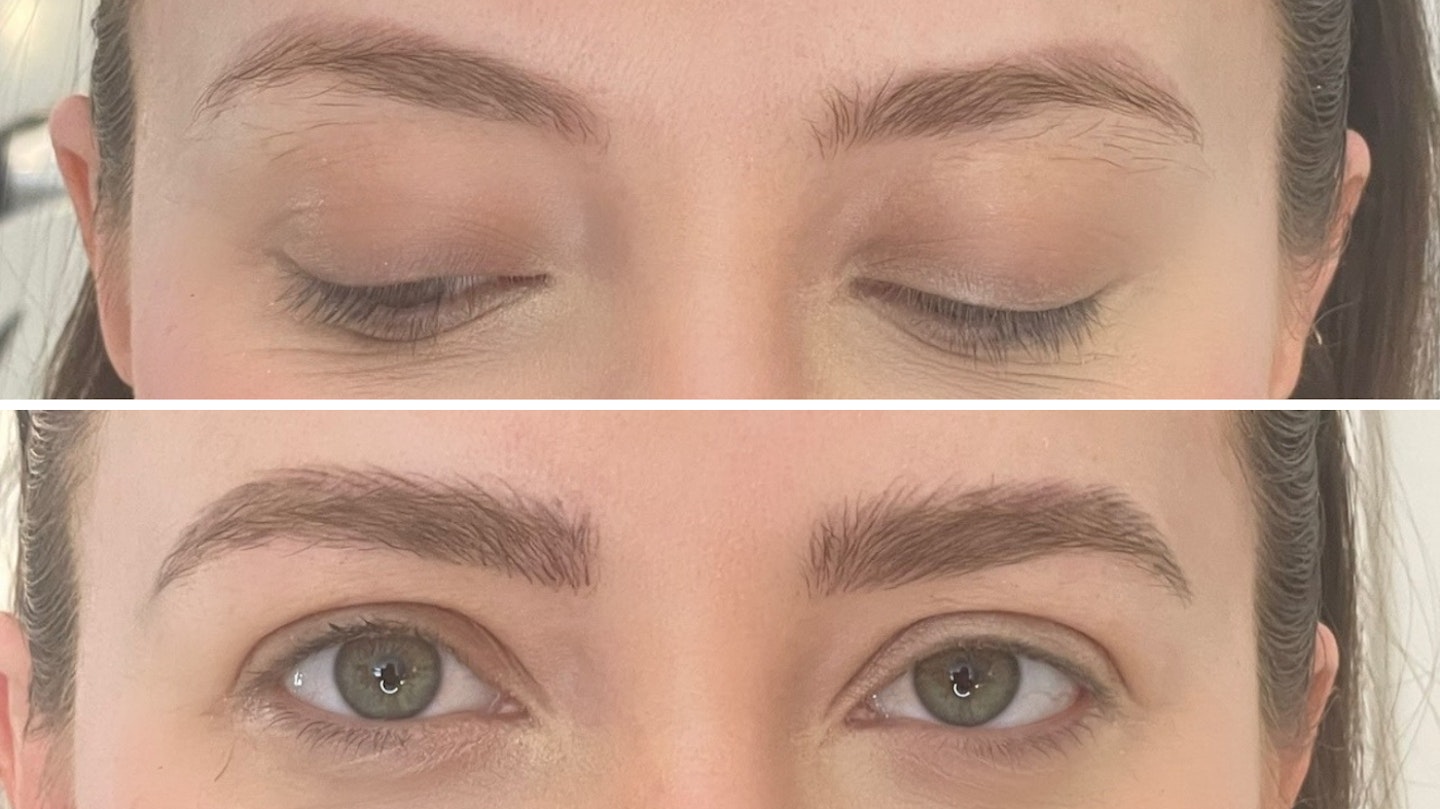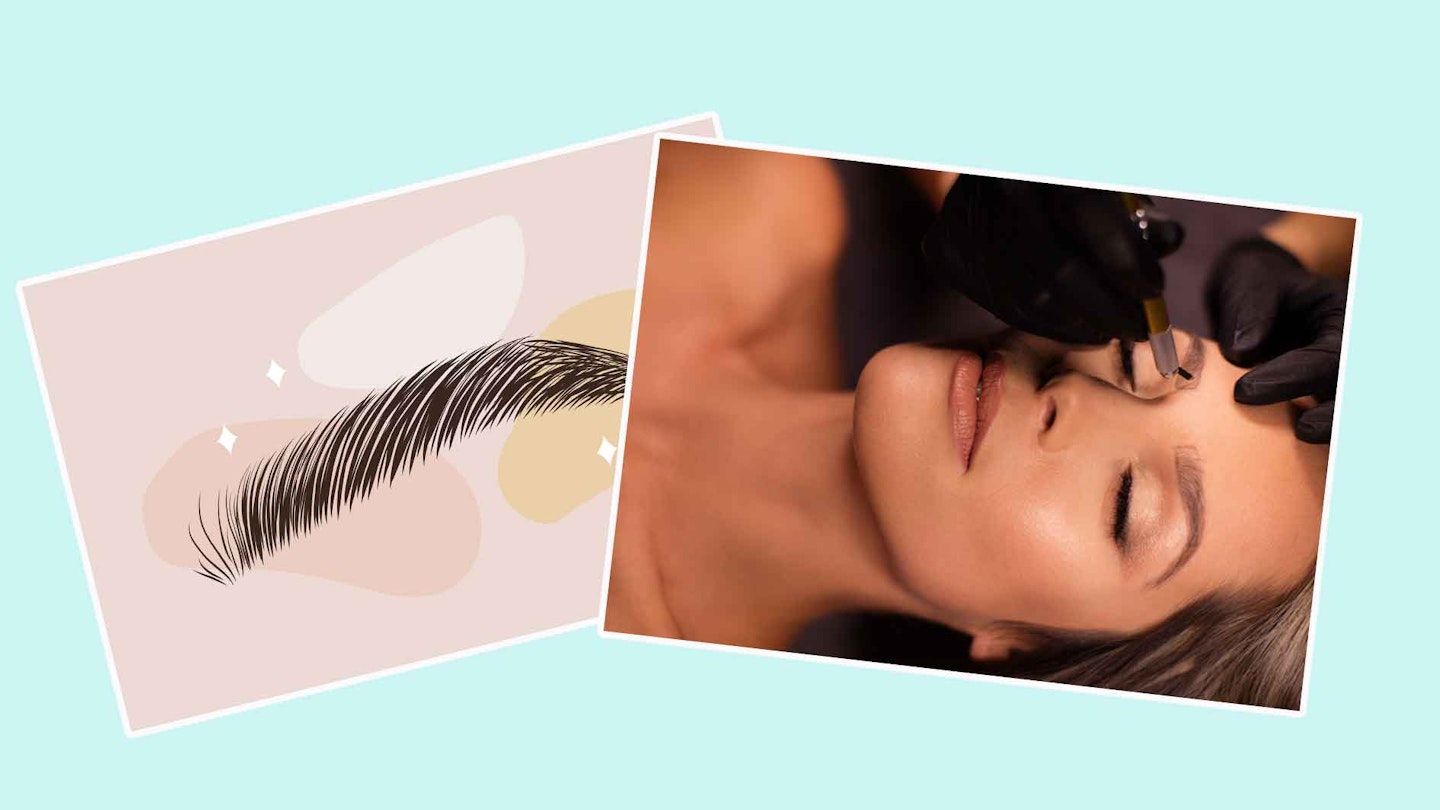Eyebrows are everything. Don’t ever let anyone tell you any different. We’re half joking, but over the last few years, we’ve seen much more emphasis put on those strange little hairy caterpillars above our eyes and a whole load of weird and whacky brow trends have been popping up on Instagram.
From brow gels that are so good they pass as brow lamination to the £6 cult wonder product that has been spotted in the hands of your fave Love Island stars, we are forever on the quest for Really Great Brows.
If you haven’t been blessed in the brow department like Cara Delevingne, or the thought of having to painstakingly draw and shade the perfect arch on a daily basis is just a bit too much – we may have found the solution.
By now you’ve probably heard of microblading. It’s a favourite among beauty influencers and celeb types, but you may have wondered what is actually involved.
We spoke to Karen Betts, leading permanent make-up artist, CEO of Nouveau HD Beauty Group, and owner of Karen Betts Clinics for the lowdown on microblading.
So, what is microblading?

"Microblading is permanent makeup performed with a hand tool and tiny blades made up of a grouping of pins," explains Karen. "Depending on how the pins are grouped together, we can create hair strokes or shading, or a combination of the two, depending on what look the client is trying to create. Microblading is the generic term for all treatments performed with the hand tool method, whether it be hair strokes or shading.
"Specific looks will have different names depending on what the technician/clinic wants to name them. For example, a fully shaded brow with no hair strokes may be called an ‘Ombre’ brow. Strokes with some shading may be a ‘Combination’ or ‘Fusion’ brow."
What's the difference between microblading and an eyebrow tattoo?
Microblading is a tattoo which sits on the dermis just like a tattoo, Karen explains. The difference is all in the techniques and ink used.
"Unlike traditional tattoos, which use a tattoo gun, microblading uses a blade-shaped tool with a row of tiny, barely visible needles to create hair-like strokes along your brows while depositing pigment into your skin.
"Traditional tattoos use ink, and microblading is done with pigment. Inks have smaller particles than pigment, which are stronger and brighter, and last longer in the skin, but will ultimately migrate (travel or blur) over time and change to undesirable hues of colour.
"Pigments are the safer option. KB Pro Pigments are not tatooo inks and aren’t made from organic (living) materials, they are highly concentrated pure pigment. Pigments have larger particles and are usually iron oxides which are more muted in tone. These fade over time and have more predictable colour changes.
"In fact, modern formulations have no undesirable colour changes at all. Fade factor is important for the face, as faces change, fashions change and tastes change and your face cannot be covered like your arm or leg can be!"
The result of a microblading tool and pigment combined? Realistic-looking brow hairs that won’t wash off for a year or more.
Karen continues, "Similarly, a lot of clients will ask, is it semi-permanent make-up or permanent makeup? At Karen Betts, we always use the term ‘permanent’, because even though the intensity of the pigment fades over time, there will always be a residue of some kind in the skin. Some people use the term ‘semi-permanent’ because of the fade factor, but both are actually referring to the same thing."
Why do I need a microblading top-up?
Microblading involves a compulsory top-up appointment to ensure flawless brows, but you may be wondering WHY.
"A second appointment is needed 4-12 weeks after your first treatment," Karen explains. "This is usually a 15-60 minutes appointment to add more pigment to the brow area. This is because as the area is healing, some parts may not ‘hold’ as well as others and you may have a few patches that need more colour. This is completely normal and everyone heals differently. Whatever the case, we advise you always come back to clinic for your Brow Builder retouch."
How do you choose which eyebrow shape for each client?
We settled on fluffy, natural-looking brows at our consultation, but how what goes into choosing your perfect eyebrow shape?
"First and foremost a thorough consultation will help establish desired results and suitability. At Karen Betts Clinics we draw the brows on with a makeup pencil during consultation. These can be drawn on and adjusted 50 times if necessary! We will never begin the tattoo process until you are completely happy with what they are going to look like.
"Photos are great as long as the client understands that we cannot replicate something exactly as the bone structure is rarely the same. However, it gives us a general idea of size and shape etc. We never use stencils as the brows must be bespoke to the individual."
Karen also has her own band of designing tools (KB Pro brow guide, KB Pro brow ruler and KB Pro pencil) to design brows for each individual client.
How long does microblading last?
"Overall, the treatment will look its best for one year, after that it may start to fade and those that prefer a darker or more defined look will require a top-up."
Does microblading hurt?
We’re not going to lie, it’s not totally pain-free. But it’s also not unbearable.
It’s pretty much how you’d imagine teeny-tiny blades to feel on your brows – a bit scratchy. It’s over pretty quickly and once you see your fancy new brows you’ll forget about all the pain.
There can be a little discomfort during the healing process, but again, it’s nothing we can’t handle in the name of fleeky af brows, right?
How can I prepare for my first microblading session?
If you have a microblading appointment in the calendar, there are plenty of ways you can prepare. First things first, stay away from the harsh skincare products.
Karen stresses, "It’s really important to consider your full beauty routine when booking a permanent makeup treatment. Your permanent makeup artist should be advising you on how to prepare as part of your consultation so that you can factor these timings in ahead of your treatment.
"In terms of brows, I recommend not grooming them for 6-8 weeks this includes not applying any tint, so I can work with your natural shape. I also advise that for the two weeks prior to your treatment you...
-
Don’t use any active skincare ingredients
-
Avoid sun exposure
-
Don’t have any facial fillers, botox or other injectables in the area
"You’ll also need to skip anything that could have a thinning effect on your blood for at least 24-48 hours. This will be different for everyone so we advise consulting your GP if you’re on any medication but in general, this includes avoiding; Ibuprofen, alcohol, isotrentinoin, caffeine, diet supplements, green tea, garlic, smoking, amongst other things which can all thin the blood. Any type of supplement or medication must be disclosed as part of our initial screening so we can decide what effect these may have on healing or pigment changes."
How important is microblading aftercare?
Aftercare is just as important as choosing the right technician to care for and protect your new brows, ensuring the best results and maximum longevity. You’ll need to adjust your regular beauty routine for the first week, including not applying makeup for the first 72 hours and avoiding actives and using gentle skincare for seven days. In addition, you shouldn’t expose skin to extreme heat (saunas, sunbeds), cold or moisture until the area has healed, which is usually around two weeks.
Karen shares her top tips on looking after your freshly microbladed brows.
-
Apply the recovery balm a minimum of four times daily. You should do this using a clean micro brush or clean cotton bud for each application (this will prevent infection)
-
Do not pick, peel, or scratch the treated area. This may result in the colour healing unevenly and you could also risk scarring and infection. Allow the wound to flake on its own.
-
Do not expose the healing skin to extreme heat, cold or moisture for two weeks following your treatment. This can include direct sun, tanning beds, Jacuzzis, saunas, salt water, chlorinated pools, direct shower spray, hot water, skin creams or ointments other than what you have been instructed to use.
-
Use SPF to avoid fading. I have just launched a brand new product for this very reason – KB Pro Grow & Protect
It's important to remember, permanent cosmetics are a low-maintenance treatment, not a no-maintenance treatment so...
-
In order to keep your permanent cosmetics in perfect condition it may be necessary to have a maintenance procedure around every 12 – 18 months, though this will vary for each individual.
-
To avoid pigment fade for as long as possible, avoid excessive exposure to the sun or UV rays
-
Take care when using moisturisers and other skin product which contain glycolic or fruity acids as these can fade permanent make-up
What’s the healing process like?
At first your eyebrows, with their newly defined shape, full look and enhanced colour will look FAB-U-LOUS. Then you’ll notice the pigment darken – don’t worry it will settle!
After about 3-5 days, your eyebrows will start to flake and peel. DO NOT PICK at the dry skin, keep applying the aftercare balm.
The flaking can last up to ten days and the colour may appear to fade to much lighter than expected. This is normal.
After about two weeks your brows will look how they’re supposed to look, but it’s important to maintain long-term care.
Keep the brow area moisturized and out of direct sunlight as much as possible.
To book an appointment with Karen Betts, check out her website here.
